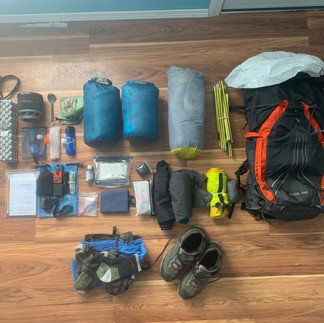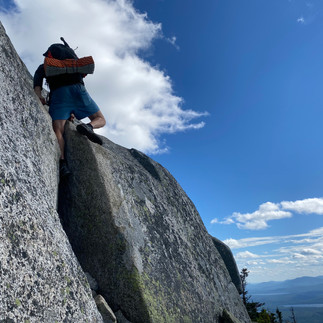Are You New to Backpack Packing? Here's Your Essential Guide to Getting Started
- AdventureEducator

- Jul 21, 2024
- 3 min read
Updated: Nov 27, 2024
Backpacking offers a thrilling way to connect with nature and discover new landscapes. Whether you’re trekking through the mountains or hiking along coastal trails, there is a sense of freedom that comes with carrying everything you need on your back. However, as a newcomer, packing your backpack can seem daunting. This guide will simplify the packing process, ensuring you are fully prepared for your upcoming adventures.
Understanding Your Backpack
Selecting the right backpack is key to a successful backpacking experience. Here’s what to keep in mind:
Size: Backpacks are categorized by their capacity in liters. For instance, a day pack (20-30 liters) works well for short hikes. In contrast, larger packs (50-70 liters) are better suited for weekend excursions or longer trips lasting several days.
Fit: Finding a backpack that fits your torso length is crucial. Many brands offer adjustable sizes, which can greatly enhance your comfort during long hikes. For example, a well-fitted pack can reduce fatigue by up to 30%.
Features: Look for padded shoulder straps, a hip belt for better weight distribution, and various compartments for easy organization. A backpack with these features can make a significant difference during long hikes.

Essential Packing Tips
Efficient packing is vital for both comfort and accessibility. Here are some effective tips to enhance your packing strategy:
1. Make a Packing List
Create a packing list before you begin. Break it down into categories such as clothing, cooking gear, tools, and personal items. This method ensures that you do not overlook important gear. For example, having a list can prevent forgetting essentials like a warm hat or sunscreen.
2. Start with a Base Layer
Pack heavier items like your sleeping bag, tent, and cooking gear at the bottom of your backpack. This arrangement provides better stability, making it more comfortable to carry.
3. Use Packing Cubes or Stuff Sacks
Invest in packing cubes or stuff sacks to improve organization. For example, group all your cooking utensils together in one sack and clothes in another. Label each sack for easy identification, making it quicker to find what you need.
4. Keep Your Sleeping Bag Accessible
After a long day of hiking, you will want to rest quickly. Place your sleeping bag at the top or in an easily accessible compartment so you can pull it out without digging through your whole pack.
5. Distribute Weight Wisely
Balance the weight in your backpack for better comfort. If items shift around while you walk, it can lead to discomfort. Tightening the straps ensures everything stays put, allowing for easier movement.
6. Consider Weather Conditions
Be sure to check the weather before your trip. Pack lightweight, moisture-wicking clothes that you can layer for warmth if it gets chilly. Make sure to include a waterproof jacket or poncho for wet weather, as getting soaked can quickly ruin your adventure.
7. Bring the Essentials
Certain items are essential on any backpacking trip. These must-haves include:
First-aid kit
Multi-tool or knife
Water purification tablets or filter
Map and compass or GPS
Fire-starting kit
Keeping these important items easily accessible can prepare you for unexpected situations.
Specific Item Recommendations
As you gear up for your adventure, consider these practical items for a smooth experience:
Cooking Gear
Select lightweight cooking gear, such as a portable stove, a small pot, and a spoon for meals. Freeze-dried meals work well due to their minimal weight and long shelf life. Many hiker favorites, like Mountain House meals, weigh less than 5 ounces and provide essential nutrients.
Clothing
Here’s a basic clothing list to get you started:
Moisture-wicking base layers
Insulating fleece or down jacket
Waterproof jacket and pants
Breathable synthetic or wool socks
Hiking Footwear
Quality footwear is crucial for a successful trip. Invest in sturdy hiking boots or shoes with good ankle support. Research shows that proper footwear can reduce blisters by more than 70%, making your trek more enjoyable.
Tips for Staying Organized on the Trail
Maintaining organization while backpacking can enhance your overall experience. Consider these strategies:
Daily Reflections: Spend a few minutes at the end of each day to reorganize your pack. This ensures everything is in its place, making it easier to find items on your next outing.
Keep Snacks Handy: Place easily accessible snacks in a front pocket or the top compartment. This way, you can refuel as needed without having to reopen your entire pack.
Use Cable Ties or Clips: These tools can secure gear to prevent rattling during your hike.
Your First Steps into Backpacking
Starting your backpacking journey is an exciting adventure waiting to unfold. By following the tips in this guide, you can better understand your gear and master packing techniques.
Remember, every trip is a chance to improve. Consider taking shorter hikes to practice your packing skills. With the right preparation, you can focus on what matters most: enjoying the beauty of the great outdoors.

Happy backpacking!












Comments